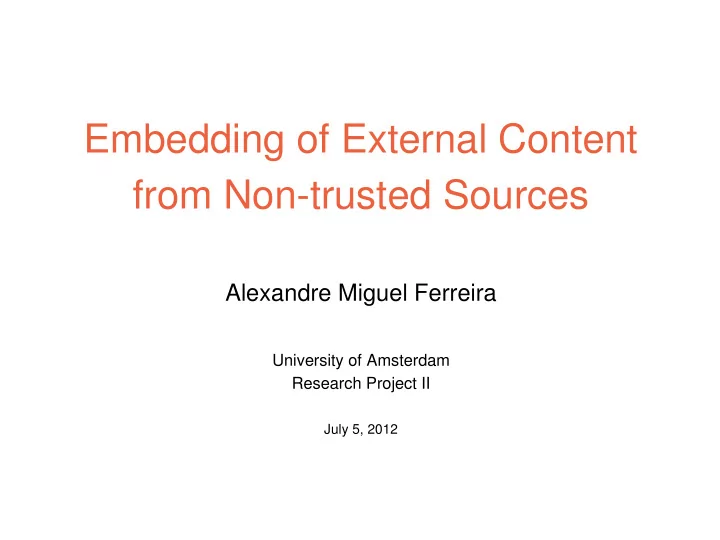

Embedding of External Content from Non-trusted Sources Alexandre Miguel Ferreira University of Amsterdam Research Project II July 5, 2012
Agenda Introduction Research Question − Background How to embed content? − − Most common attacks Results − Testing Methods − Possible Solutions Conclusions − Futures work Questions
Introduction Target websites e-banking − − e-commerce Embedded third-parties content − Bank partners advertising Social networks − Not all on the same trusted degree!
Introduction Research Question How to securely embed content from non-trusted sources on a website? − How to create trusted content from untrusted content? − Which vulnerabilities have to be secured? How do different browsers handle the problem? − − How much user intervention is required for the different solutions? What can be secured by the bank server? − − What can the bank do to secure third parties’ servers? − What can be done to have a third party to be considered trusted?
Background How to embed content? Content can be included with: − S cripts → <script type="text/javascript">ajaxinclude ("filename.html")</script> − Inline frames → <iframe src=" https://www.os3.nl/“></iframe> What is an Iframe? − HTML document embedded inside another HTML document on a website − Behaves as an inline image, but can be configured independently from HTML content where it is embed More secure than scripts −
Background Most common attacks{1} Cross-site Scripting OWASP Top Ten Project 2010 (A2) − Cross-site Request Forgery OWASP Top Ten Project 2010 (A5) − Phishing − One of the highest visibility problems for e-banking and e-commerce websites
Background Most common attacks{2} C ross-site Scripting (XSS) Allow attackers to execute − malicious JavaScript code, pretending that the application is sending the code to the user Attacker is able to execute scripts − in the victims browser which can be used to hijack users sessions, among others
Background Most common attacks{3} C ross-site Request Forgery (CSRF) Allows an attacker to send − requests on behalf of a client without knowledge or interaction from the client Attacker can force the victims − browser to perform a hostile action, benefiting from this
Background Most common attacks{4} Phishing Good example of social − engineering Attacker attempts to obtain − informations about the user by misleading him/her Done by masquerading as a − trustworthy entity (the bank in this case)
Results Testing Methods Banking website simulated with some flaws Inclusion of tree Iframes with attacks to the website − XSS attack – Session hijacking by stealing cookies CSRF attack – Clickable link that will do a POST request, on behalf of the user, − to do a new transaction − Phishing attack – Request to change the user's password Three web browsers tested: − Firefox − Google Chrome − Internet Explorer 8
Results Possible Solutions Web Browsers’ Security Server-side protections Autommated scanners
Results Possible Solutions – Web Browsers’ Security Web XSS CSRF Phishing browser/Attack Same-origin policy Use of add-ons Phishing Protection Firefox protection such as: feature* CsFire* RequestPolicy* NoScript* Same-origin policy HTML5 JavaScript “Enable phishing Google protection Sandbox and malware Chrome protection” option* Same-origin policy SmartScreen Filter* Internet protection Explorer 8 * User intervention required
Results Possible Solutions – Server-side Protection XSS not tested ( tested web browsers handled it) CSRF protections − Filtering proxy Double submit (variation of the token identification scheme) − − Apache mod_security module (can be called web application firewall) Phishing protections − Nothing can be done by server-side! − Alert costumers is the best thing to do!
Results Possible Solutions – Automated Scanners Scans the website for malicious content It was considered, but … … cannot be considered as protection Attacks can be performed in such a way that it can be misled − − It would only function as a problem detection Can be a solution to transform untrusted content into trusted content − … but then again it can be misled
Conclusions Ideally all the vulnerabilities should be protected (XSS, CSRF and Phishing most common) All the tested web browsers are protected against XSS (same-origin policy) Most of web browsers' features require user intervention Phishing is probably the most difficult vulnerability to prevent The use of automated scanners can be a solution to transform untrusted content into trusted content, though filtering proxies might do a better job CSRF difficult to be protected by web browsers, server side solutions (filtering proxies or double submit) are better In order to protect third parties' servers, the same protection methods used by the bank should be used Having third parties being audited by the bank should be enough to consider them more trustuble
Conclusions Future Work More web browsers tested Opera − − Safari − Android More attacks tested − Pharming − Man-in-the-Browser (MitB)
Questions Thanks to: Sander Vos − Steven Raspe − Further questions: alexandre.miguelferreira@os3.nl − ferreira.alexandremiguel@gmail.com −
Recommend
More recommend